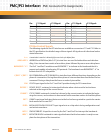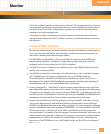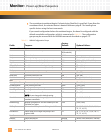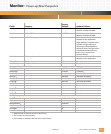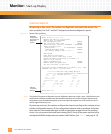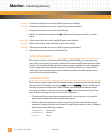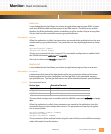
Monitor: Initializing Memory
PmT1 and PmE1 User’s Manual 10002367-02
8-6
ce or cE: Change text to the end of a word (capital E ignores punctuation).
cb or cB: Change the word before the cursor (capital B ignores punctuation).
c$: Change text from the cursor to the end of the line.
d: Delete. Use additional commands with d to delete words or groups of words, as shown
below.
dw or dW: Delete a word after the cursor (capital W ignores punctuation).
de or dE: Delete to the end of a word (capital E ignores punctuation).
db or dB: Delete the word before the cursor (capital B ignores punctuation).
d$: Delete text from the cursor to the end of the line.
INITIALIZING MEMORY
The monitor uses the area between 0000,0000
16
and 0001,0000
16
for interrupt vector,
stack, data, and bss space. Any writes to that area can cause unpredictable operation of the
monitor. The monitor initializes all local memory on power-up and/or on reset, depending
on the configuration of nonvolatile memory. The monitor initializes (i.e., writes to) this
area, but it is left up to the programmer to initialize any other accessible memory areas,
such as off-card or module memory.
COMMAND SYNTAX
Each command may be typed with the shortest number of characters that uniquely identify
the command. For example, you can type nvd instead of nvdisplay. (There is no distinction
between uppercase and lowercase.) Note, however, that abbreviated command names
cannot be used with on-line help; you must type help and the full command name. Press
Enter or Return (carriage return <cr>) to execute a command.
• The command line accepts three argument formats: string, numeric, and symbolic.
Arguments to commands must be separated by spaces.
• Monitor commands that expect numeric arguments assume a default base for each
argument. However, the base can be altered or specified by entering a colon (:) followed
by the base as in the following examples.
1234ABCD:16 hexadecimal
123456789:10 decimal
101010:2 binary



